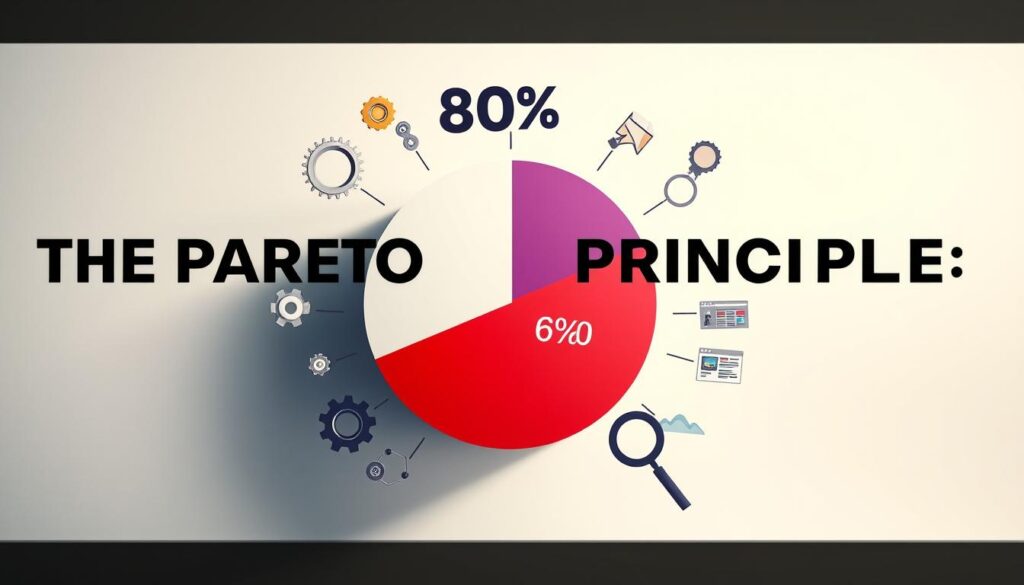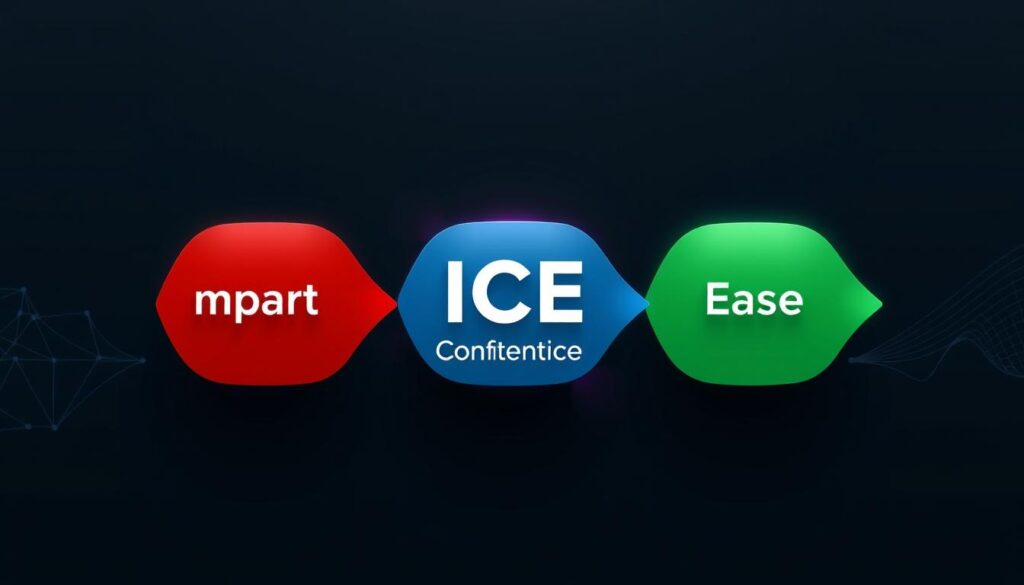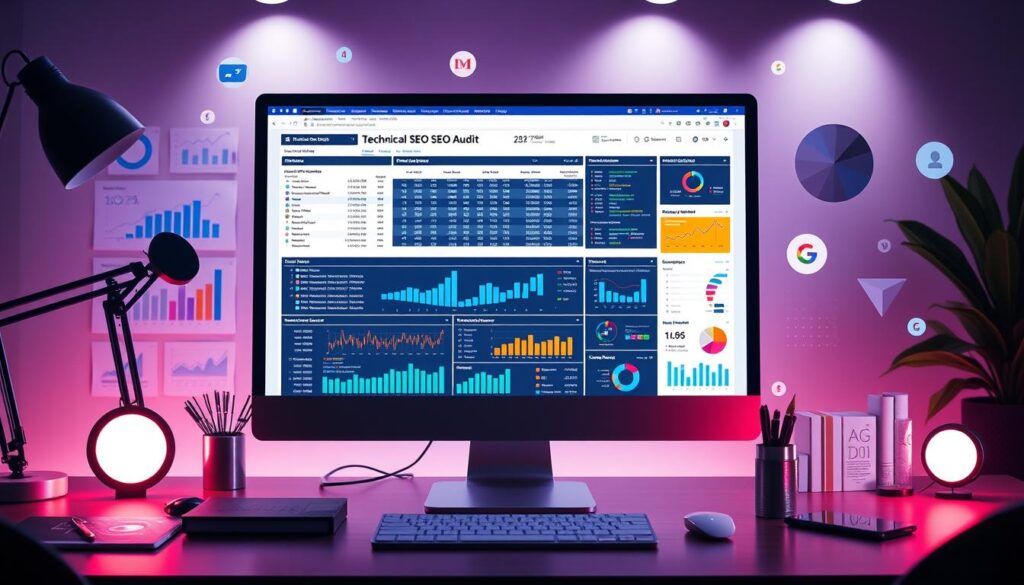As an SEO pro, I’ve seen many challenges in technical SEO audits. Bad audits waste time, miss important issues, and hurt client trust. This can lead to lost chances for better search rankings and more visitors.
With five years of experience with top U.S. brands, I’ve learned key tips. These tips help you make audits that really make a difference.
Key Takeaways
- Focus on identifying the 20% of factors that drive 80% of SEO outcomes, known as the Pareto Principle1
- Analyze the distribution of traffic and keywords to uncover high-impact opportunities1
- Prioritize recommendations using the ICE framework to score changes by Impact, Confidence, and Ease1
- Provide actionable advice and clear “Key Takeaways” to ensure client understanding and implementation1
- Combine automated tools with expert analysis to leverage the strengths of both1
Focus on identifying key constraints and the 80-20 rule
When you start a technical SEO audit, it’s key to find the main issues. The Pareto Principle, or 80-20 rule, shows that 80% of results come from 20% of efforts2. Knowing where most of your site’s traffic and keywords are helps you pick the best changes to make.
Sorting audit items by their impact is a smart move. At our agency, we’ve seen that the most impactful changes usually fall into four groups. These are big changes, ones that target important keywords, pattern-based fixes, and site quality improvements3.
Analyze the Potential Impact of Different Changes
Think about how changes might affect your site’s top keywords or have a wider but smaller impact2. This way, you focus on the changes that will make the biggest difference for your client.
To make your recommendations even better, use the ICE framework. It looks at the Impact, Confidence, and Ease of each change. This helps you make a list that balances big wins with what’s easy to do3.

A top-notch technical SEO audit zeroes in on the most important items. By using the Pareto Principle and understanding your site’s traffic and keywords, you can create a valuable audit. This audit will help your clients reach their goals2.
Prioritize recommendations using the ICE framework
To make sure your team thinks about impact and ease of execution, use the ICE framework in your technical SEO audit. This method helps you look at the key traits of a good audit item. These are Impact (how much will this change matter?), Confidence (how sure are you it will work?), and Ease of execution (how hard or long will it take to do it?)4.
By scoring each idea on these three points, you can make a list that shows what’s most important and doable. This way, you balance what could be gained with what’s practical.
- The ICE scoring model gives scores from 1 to 10 for impact, confidence, and ease4.
- The PIF framework looks at tasks by potential, importance, and ease4.
- The Rice scoring model uses reach, impact, confidence, and effort for task analysis4.
- The cost-benefit analysis matrix compares task costs to benefits4.
By doing this, your team can focus on the most important and easy-to-do changes. These will likely give the best results for your client. Remember, a 7-hour project is over 20% of the usual 25-30 hours a week4.

The ICE framework is a simple yet powerful tool for prioritizing your technical SEO audit suggestions. It helps your team use their time and resources wisely. By thinking about impact, confidence, and ease of execution, you can find the big changes that will really help your client’s online presence.
Provide actionable advice, not just raw data
When you do a technical SEO audit, it’s important to do more than just show problems. You should give your clients clear steps to fix these issues. This way, you show you’re more than just a problem finder. You’re a trusted guide who helps improve their website.
Propose Specific Solutions for Identified Issues
Instead of just listing problems, offer specific fixes. For example, if you find 20 broken backlinks, rank them by impact. Then, suggest the best way to fix each one, starting with the most important5. For missing headers, suggest new ones that are better for search and explain why they’re good for the page.
Include Clear “Key Takeaways” Section
Every audit should have a “Key Takeaways” section. It should highlight the most urgent issues and what to do next. For example, “Fix the top 5 broken backlinks first, as they’re the biggest problem. Add the new headers to the homepage and top 3 product pages to boost keywords. Meet up soon to talk about how and when to do it.”5 This turns the audit into a plan for bettering the website, showing you know how to solve problems.
By adding these parts, your SEO audits become more than just data. They’re actionable, helpful, and show you really get what your clients need. This makes you a valued partner in their SEO journey.

Combine automated tools with expert analysis
Automated tools are great for starting data collection. But, relying only on their lists has big downsides. Automated audits miss the fine details of a website’s needs; they just follow a set list of checks. A good audit is all about exploring and understanding6.
Many start with automated tools, but it’s smarter to first look at keywords and traffic patterns. Focusing on keyword rankings gives deeper insights and spots major problems. For example, tools might say to speed up your site by offloading scripts or improving largest contentful paint. But, start by checking your most important keywords and compare your site to your competitors. You might find your site’s speed is already good, meaning small improvements won’t make a big difference in traffic6.
Automated tools are helpful, but they can’t replace human expertise in SEO audits. A good audit mixes automated data with expert insights, focusing on key keywords and user experience to really boost SEO6.
- Automated tools can handle lots of data quickly, giving detailed audits7.
- AI can quickly find technical problems like broken links and duplicate content, fixing them fast to avoid SEO harm6.
- Websites checked with AI tend to load faster and work better on mobiles, making users happier6.
- AI can spot data patterns for future insights, helping businesses plan better SEO strategies6.
- Using AI in technical SEO audits is key to staying ahead online6.

By mixing automated tools and human expertise, you can do high-impact SEO audits. The trick is to find the right mix of keyword-driven analysis and user experience optimization. This way, you use the best of both worlds.
technical SEO audits: Identifying high-impact initiatives
The 80/20 rule is key in technical SEO audits8. Big companies face challenges in coordinating SEO efforts because of different departments8. Making sure every page follows the same rules is hard to avoid penalties8.
It’s important to focus on high-impact SEO efforts for better results8. Traditional SEO works well for small sites, but big sites need a different strategy8. This means finding the most impactful SEO opportunities is crucial.
- Understand the distribution of traffic and keywords: Analyze which pages and keywords are driving the most traffic and potential impact8.
- Analyze the potential impact of different changes: Evaluate the possible gains from various SEO initiatives, prioritizing those that can yield the highest returns8.
- Categorize audit items by their type of impact: Distinguish between high-impact and low-impact tasks to focus your efforts accordingly8.
Ignoring high-impact SEO can lead to the “SEO death spiral”8. This means the company stops believing in the strategy and avoids SEO work. This cycle can repeat for years8.
By focusing on the 80/20 rule and identifying key SEO initiatives, you can help your clients succeed long-term8.
Educate the client on SEO principles
A successful consulting relationship is more than just giving advice. It’s about teaching the client about search engine optimization (SEO). Use audits as a chance to teach them something valuable. This knowledge will help them long after the audit is done9.
Turn the Audit into a Valuable Learning Experience
By explaining your reasons, you empower the client to make smart choices. They’ll understand SEO better. Talk about how page speed, keywords, and user experience affect rankings910.
Walk the client through the audit’s findings. Explaining each point helps them see the audit’s value. It also makes them feel more involved in the process.9
An informed client is a better partner in SEO. They’ll help achieve better results over time. By teaching them about SEO, you start a lasting, beneficial relationship910.
- Stress the role of technical SEO in improving website visibility10.
- Explain how page speed, mobile-friendliness, and HTTPS affect rankings and user experience10.
- Point out the benefits of long-tail keywords and natural keyword use in attracting leads9.
- Talk about how visuals like photos and videos improve user engagement and content usability9.
By making the audit a learning experience, you help the client grasp SEO. You also build a strong, lasting partnership910.
Avoid the SEO death spiral
Many businesses get stuck in the “SEO death spiral.” They lose hope in their SEO plans and stop doing important work. This usually happens after about 12 months11.
SEO agencies often give long lists of tasks. But, only 5-10% of these tasks are actually done. And, they don’t lead to any noticeable changes in traffic11.
To get out of this cycle, it’s key to find and focus on the most important SEO tasks11. About 5% of SEO work brings 95% of the results11. So, it’s vital to focus on the tasks that really matter and avoid wasting time on less important ones11.
Offering practical advice and teaching your clients about SEO can change the game. It turns the audit into a plan for lasting improvement11. This shows your knowledge and adds more value to your partnership11.
By using the scientific method, you can find the most effective SEO actions. This involves analyzing data, testing hypotheses, and validating results11. This way, you can skip over tasks that don’t make a difference, like title tag length or page speed11.
The secret to escaping the SEO death spiral is to give your clients a clear, long-term plan. This plan should show real results11. By focusing on key tasks and teaching your clients, you can turn the SEO audit into a chance for growth11.
Conclusion
Technical SEO audits are key to a good SEO plan. They help websites show up better on search engines and rank higher for important keywords12. These audits fix technical problems, making websites easier to use and more satisfying for visitors12.
They also help businesses stay ahead by finding what their competitors do well and improving on it12.
To make technical SEO audits work, focus on the most important fixes. Use the Pareto Principle and frameworks like ICE to sort and prioritize12. Giving clear advice and mixing automated tools with expert insights leads to real improvements1213.
The goal of technical SEO audits is to teach clients and build a lasting partnership13. By teaching SEO basics and avoiding common mistakes, businesses can start a successful partnership13.
FAQ
What are the key tips for delivering high-impact technical SEO audits?
How can I identify and prioritize the most impactful changes in a technical SEO audit?
What is the ICE framework and how can it help prioritize recommendations in a technical SEO audit?
How can I ensure my technical SEO audit provides actionable advice and solutions to the client?
How can I combine automated tools with expert analysis for more effective technical SEO audits?
What is the “SEO death spiral” and how can I avoid it?
How can I turn the technical SEO audit process into a valuable learning experience for the client?
Source Links
- https://searchengineland.com/7-tips-for-delivering-high-impact-technical-seo-audits-446405
- https://agencyanalytics.com/blog/pareto-principle-80-20-rule
- https://www.dmcdigital.marketing/search-engine-optimization/
- https://searchengineland.com/?p=445412
- https://agencyanalytics.com/blog/technical-seo-site-audit
- https://medium.com/@jakecaksd/automating-technical-seo-audits-with-ai-a3fa8dae376e
- https://seranking.com/website-audit.html
- https://www.webstacks.com/blog/enterprise-technical-seo
- https://www.webfx.com/blog/seo/seo-principles/
- https://www.semrush.com/blog/technical-seo/
- https://www.linkedin.com/posts/ethanls_the-5-high-impact-seo-initiatives-here-activity-7141460874292002816-0RdG
- https://seobase.com/a-quick-guide-to-technical-seo-audit
- https://www.customerly.io/glossary/seo-audit/








